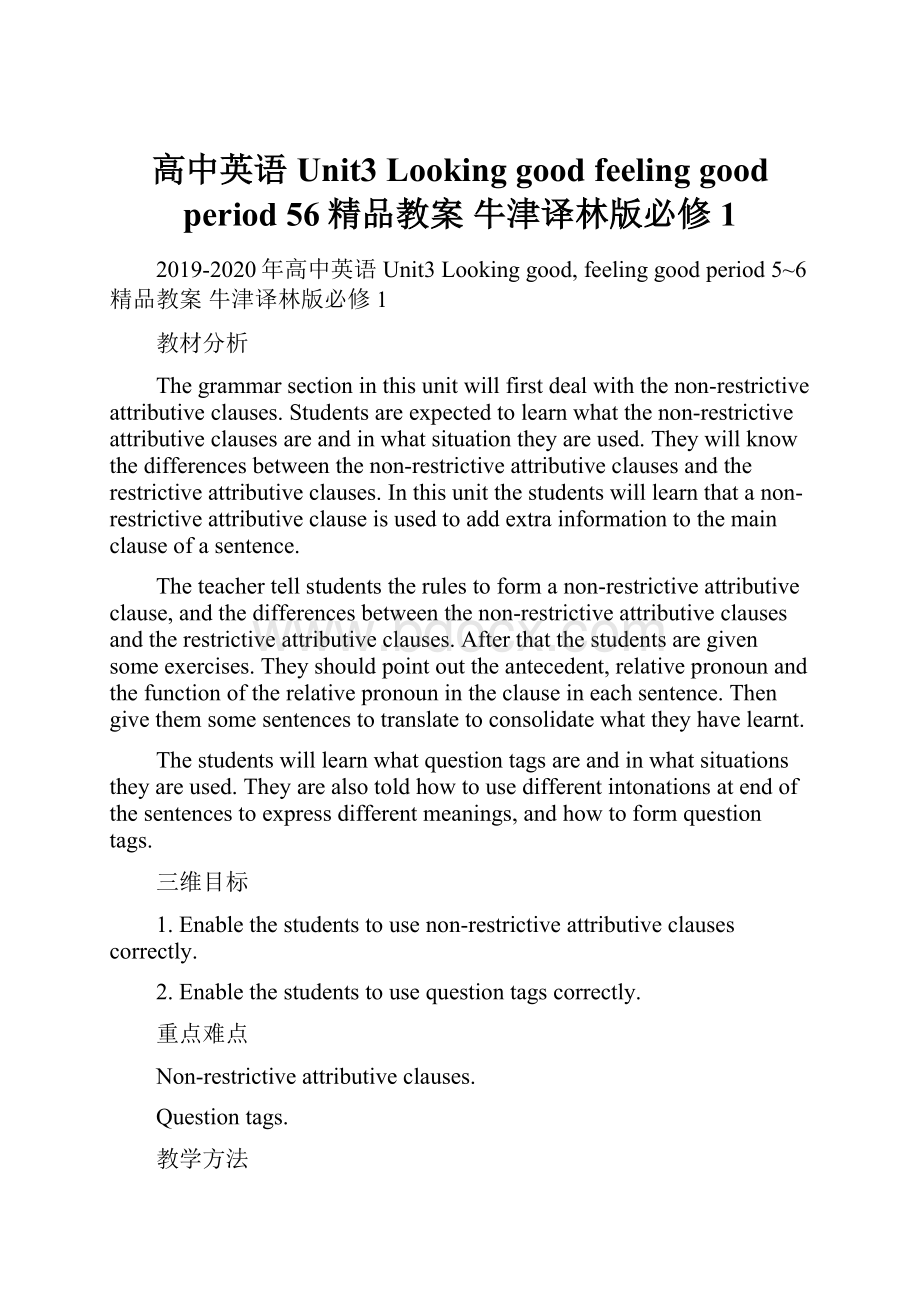高中英语 Unit3 Looking good feeling good period 56精品教案 牛津译林版必修1.docx
《高中英语 Unit3 Looking good feeling good period 56精品教案 牛津译林版必修1.docx》由会员分享,可在线阅读,更多相关《高中英语 Unit3 Looking good feeling good period 56精品教案 牛津译林版必修1.docx(37页珍藏版)》请在冰豆网上搜索。

高中英语Unit3Lookinggoodfeelinggoodperiod56精品教案牛津译林版必修1
2019-2020年高中英语Unit3Lookinggood,feelinggoodperiod5~6精品教案牛津译林版必修1
教材分析
Thegrammarsectioninthisunitwillfirstdealwiththenon-restrictiveattributiveclauses.Studentsareexpectedtolearnwhatthenon-restrictiveattributiveclausesareandinwhatsituationtheyareused.Theywillknowthedifferencesbetweenthenon-restrictiveattributiveclausesandtherestrictiveattributiveclauses.Inthisunitthestudentswilllearnthatanon-restrictiveattributiveclauseisusedtoaddextrainformationtothemainclauseofasentence.
Theteachertellstudentstherulestoformanon-restrictiveattributiveclause,andthedifferencesbetweenthenon-restrictiveattributiveclausesandtherestrictiveattributiveclauses.Afterthatthestudentsaregivensomeexercises.Theyshouldpointouttheantecedent,relativepronounandthefunctionoftherelativepronounintheclauseineachsentence.Thengivethemsomesentencestotranslatetoconsolidatewhattheyhavelearnt.
Thestudentswilllearnwhatquestiontagsareandinwhatsituationstheyareused.Theyarealsotoldhowtousedifferentintonationsatendofthesentencestoexpressdifferentmeanings,andhowtoformquestiontags.
三维目标
1.Enablethestudentstousenon-restrictiveattributiveclausescorrectly.
2.Enablethestudentstousequestiontagscorrectly.
重点难点
Non-restrictiveattributiveclauses.
Questiontags.
教学方法
1.Discussioninpairsoringroups.
2.Task-basedin-classactivities.
3.Explanationsofsomerulesoftheattributiveclauseandquestiontags.
教具准备
Aputerandsomeslides.
课前准备
1.Askthestudentstogoovertheattributiveclausesintroducedbywhich,that,who,whom,whoseandpreposition+whichandpreposition+whom,andrelativeadverbs:
when,whereandwhy.Letthemdosomeexercisesaboutit.
2.AskthestudentstofindoutallthesentencesincludingattributiveclausesinreadingandtrytheirbesttotranslatethemintoChinese.
3.Findoutthedifferencesbetweentheseattributiveclausesandtheclausestheylearned.
4.Askthestudentstomakeanamazingstoryusingtheattributiveclausestheyhavelearned.
教学过程
→Step1Revision&Lead-in
Askthestudentssomequestionsaboutwhattheyhavelearnedinlastperiod.
Haveapetitionbetweenthedifferentgroups.
Askthemtotellthestorytheyhaveprepared.Theteacherjudgesthestoriesthestudentstellandgivethemdifferentmarksaccordingtotheattributiveclausestheyuseintheirstories.
→Step2Non-restrictiveattributiveclauses
1.Letthestudentsreadthefiveexamplesinpoint1.
2.Tellthestudentswhatanon-restrictiveattributiveclauseis.
Anon-restrictiveattributiveclauseisaclausethataddsextrainformationtothemainclauseofasentence.Thereisusuallyama(,)beforeit.
Askthestudentstofindthesimilaritiesandthedifferencesbetweentherestrictiveattributiveclausesandthenon-restrictiveattributiveclauses.
1)Bothofthemareusedafteranoun.
2)Thenon-restrictiveclauseaddsextrainformationtothemainclauseofasentenceandcanbeleftoutwithoutanyconfusion.Forarestrictiveclause,itisanecessarypartofthesentence,andifitisleftout,themeaningofthewholesentencewillnotbesoclear.
3)Thereisusuallyamabeforeanon-restrictiveattributiveclause.
4)Wecanneveruse“that”tobeginanon-restrictiveattributiveclause.
5)Wecanusewhichtorefertothewholeofthemainclauseinthenon-restrictiveattributiveclauses.
3.Askthestudentstopointouttheattributiveclausesinreading.
1)SinceI’mpreparingtoactinanewplay,I’mtakingweight-losspillscalledFat-less,whicharequitepopularamongyoungwomenhere.
2)Mymother,whomyoumetlastyear,keepstellingmenottotakethembecausetheyaredangerous.
3)Thenthedoctorfoundthatsomeoneinyourcountry,whosenameisLiDong,wasanexactmatchforme.
4)It’sthesameinChina—manypeople,someofwhomarenotoverweightatall,arealwaysgoingondietsortakingweight-losspills,whichareoftendangerous.
→Step3Practice
AskthestudentstotranslatesomesentencesintoEnglishusingthenon-restrictiveattributiveclauses.
1.Thisisthecarwhichweboughtlastmonth.
2.Thisisthecar,whichweboughtlastmonth.
3.Hefailedinthemathexam,whichmadehisparentsverysad.
4.Itrainedhardyesterday,whichpreventedmefromgoingtothepark.
5.Theresultoftheexperimentwasverygood,whichwehadexpected.
6.Hemissedtheshow,whichwasagreatpity.
7.Shewasawardedagoldmedal,whichthewholefamilyconsideredagreathonor.
8.Shewasverypatientwiththechildren,whichherhusbandseldomwas.
→Step4Questiontags
1.Letthestudentsreadtheguidelinesathebeginningofthispart.Askthemtosaywhatdifferentsituationsquestiontagsareused.
2.Therulesofhowtoformaquestiontag.
反意疑问句(tagquestion)又叫附加疑问句,是在陈述句后,对陈述句所叙述的事提出的疑问。
其基本结构有两种:
1)“肯定陈述句+简略否定问句”;
2)“否定陈述句+简略肯定问句”。
反意疑问句的前后两部分在时态,人称和数上都要保持一致。
Itlookslikerain,doesn’tit?
Hedoesn’tneedtoworksolate,doeshe?
3)陈述部分的主语是this,that时,疑问部分的主语多用it;陈述部分的主语是these,those时,疑问部分的主语多用they。
Thisisadictionary,isn’tit?
Thoseareshelves,aren’tthey?
4)陈述部分是“therebe”结构的,疑问部分用there省略主语代词。
Thereissomethingwrongwithyourwatch,isn’tthere?
Therewillnotbeanytrouble,willthere?
5)陈述句中含有not,no,hardly,neither,never,few,little,too...to等否定词或具有否定意义的词时,疑问部分常用肯定形式。
如:
Fewpeopleknewthenews,didthey?
TomhasneverbeentoEngland,hashe?
6)如果陈述句的主语是something,nothing,anything,everything等不定代词时,反意疑问部分的主语多用it。
7)如果主语是I’m,后反意部分用aren’tI。
I’mlate,aren’tI?
8)附加问句一般与主句的主谓保持一致,但当陈述部分的主语是Isuppose,Ithink,Ibelieve,Isuspect,Iimagine,Iguess(主语还可以是we)等结构时,附加问句往往与that从句中的主谓保持一致。
9)当陈述部分带有情态动词must时,如表示“必须”,附加问句用must;如表示猜测,附加问句根据具体语境用适当的形式。
如:
Hemustbeverytired,isn’the?
Hemusthaveseenthefilm,hasn’the?
Hemusthaveseenthefilmlastnight,didn’the?
10)祈使句Imperativesentences:
Don’tmovethechair,willyou?
Givemesomepaper,canyou?
Let’sgoshopping,shallwe?
Letushavealookatyourbook,willyou?
11)Attention:
(1)简短问句的否定形式,要用缩写形式,不能出现not,主语要用人称代词不能用名词.
Hermotherisadoctor,isn’tshe?
Thereisabookonthedesk,isn’tthere?
(2)对反意疑问句的回答,是根据事实,而不是根据问题的提法。
Heisn’tadoctor,ishe?
(他不是医生,是吗?
)
Yes,heis.(不,他是医生。
)
No,heisn’t.(是的,他不是医生。
)
(3)Sincethestudentshavelearnedhowtoformaquestiontag,askthemtofinishtheexercisesonpage42,andPartC2onpage96inworkbook.Iftimeislimitedinclass,itcanbeassignedastheirhomework.
(4)Askstudentstodosomeexercises
①TheboyisJapanese,_____________he?
②Thebookisn’tinteresting,_____________it?
③HeknowsalotaboutEnglishnames,_____________he?
④Thegirldoesn’tlikeapples,_____________she?
⑤Therearetwobirdsinthetree,_____________there?
⑥ThemancametoChinalastmonth,_____________he?
→Step5Homework
1.Finishtheexercisesbelowonthepaper.
2.ReviewGrammarandusageofthisunit
板书设计
1.陈述部分的主语是this,that时,疑问部分的主语多用it;陈述部分的主语是these,those时,疑问部分的主语多用they。
Thisisadictionary,isn’tit?
Thoseareshelves,aren’tthey?
2.陈述部分是“therebe”结构的,疑问部分用there省略主语代词。
Thereissomethingwrongwithyourwatch,isn’tthere?
Therewillnotbeanytrouble,willthere?
3.陈述句中含有not,no,hardly,neither,never,few,little,too...to等否定词或具有否定意义的词时,疑问部分常用肯定形式。
如:
Fewpeopleknewthenews,didthey?
TomhasneverbeentoEngland,hashe?
4.如果陈述句的主语是something,nothing,anything,everything等不定代词时,反意疑问部分的主语多用it。
5.如果主语是I’m,后反意部分用aren’tI
I’mlate,aren’tI?
6.附加问句一般与主句的主谓保持一致,但当陈述部分的主语是Isuppose,Ithink,Ibelieve,Isuspect,Iimagine,Iguess(主语还可以是we)等结构时,附加问句往往与that从句中的主谓保持一致。
7.当陈述部分带有情态动词must时,如表示“必须”,附加问句用must;如表示猜测,附加问句根据具体语境用适当的形式:
Hemustbeverytired,isn’the?
Hemusthaveseenthefilm,hasn’the?
Hemusthaveseenthefilmlastnight,didn’the?
8.祈使句Imperativesentence:
Don’tmovethechair,willyou?
Givemesomepaper,canyou?
Let’sgoshopping,shallwe?
Letushavealookatyourbook,willyou?
Attention:
1.简短问句的否定形式,要用缩写形式,不能出现not,主语要用人称代词不能用名词。
Hermotherisadoctor,isn’tshe?
Thereisabookonthedesk,isn’tthere?
2.对反意疑问句的回答,是根据事实,而不是根据问题的提法。
Heisn’tadoctor,ishe?
(他不是医生,是吗?
)
Yes,heis.(不,他是医生。
)
No,heisn’t.(是的,他不是医生。
)
精彩片断
Haveapetitionbetweengroupstotelltheamazingstoriestheyhaveprepared.Thestudentsareactiveinclass.
2019-2020年高中英语Unit3Lookinggood,feelinggoodperiod7~8精品教案牛津译林版必修1
教材分析
Thissectiondealswithinvitingafriendtojoinagym.Integratedrelevanttasksandactivitiesaboutfindinginformationaboutagymandremendingonetoafriendbynote-takingandwritingane-mailarepresented.
Thissectionconsistsofaseriesofactivities,whichprovidestudentsopportunitiestolearnandpracticetheirlanguageskillsoflistening,reading,speakingandwriting.
三维目标
1.Learnsomeimportantwordsandexpressions
gym,remend,personal,membership,yoga,aerobics,muscles,closeup,joinagym,what’smore,makethemostof
2.Learnsomeimportantsentencepatterns
1)What’smore,forthenexttwoweeksweareoffering1monthfreemembership.
2)Writealettertohim,explainingwhyyouthinkheshouldjointhegym.
3)Heistryingtofindagymmembershiphecanafford.
3.Helpstudentslearnhowtofindtheinformationtheywanttoknowquicklyinalongpassageandtakenotes.
4.Enablestudentstowritealettertoremendagymtoafriend.
重点难点
Helpthestudentstofindinformationquicklyandwritingalettertoremendagymtoafriend.
Guidethestudentstotakenotesandusepunctuation.
Encouragethestudents